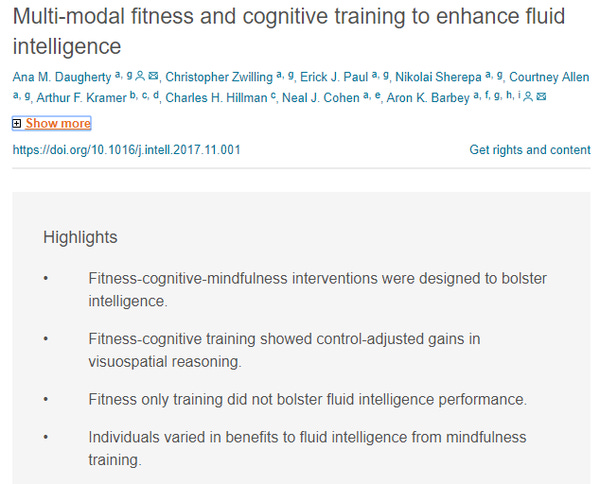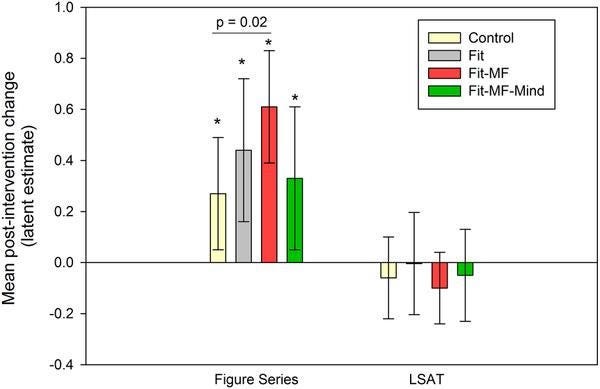This was written by Mark Ashton Smith, Ph.D., and originally published in his excellent newsletter for IQ Mindware.
I’ve had a few queries about the status of mindfulness meditation practice in the recent Feb 2018 Intelligence study showing gains in fluid intelligence from multi-modal brain cross-training. In this message, I’d like to clarify some of what we know about mindfulness meditation from this study.
First here’s a summary of the findings:
Summary
The study was a comprehensive 4-month placebo-controlled trial, with 424 healthy adults (age 18–43 years, 50% Caucasian).
The conclusions are shown in the screenshot from the journal article here (click the image to access the article):
The research team concludes:
“Because fluid intelligence test scores predict real-world outcomes across the lifespan, boosting intelligence ability via multi-modal intervention that is effective even in young, healthy adults is a promising avenue to improve reasoning and decision making in daily life.”
Unlike other brain training apps showing null results in the lab after training, this kind of training method — also implemented in the IQ Mindware apps — takes a multi-modal approach — combining both dual n-back (working memory) training with executive control (attention) training.
These results are in line with previous results and help make sense of studies showing no IQ gains from working memory training, when clearly the right type of brain training helps considerably. Here is what we now know.
Combining attention training with working memory (dual n-back) training is more effective than either alone.
Visuospatial intelligence benefits from training while verbal reasoning does not.
Combining the cognitive training with exercise improves the intelligence gains.
Does Meditation Help Or Hinder?
What was puzzling about this study was that while the pattern of results for the most part made perfect sense, the condition where participants did meditation apparently did not.
The researchers compared the effects of four types of training on both visuospatial and verbal fluid intelligence:
(1) Fitness training (Fit group)
(2) Fitness training and cognitive training (Fit-MF group)
(3) Fitness, cognitive training, and mindfulness meditation (Fit-MF-Mind group)
(4) Perceptual training (Control group)
The ‘cognitive training’ involved specifically.
Working memory training (e.g. the dual n-back)
Executive control / attention training
Visuospatial logic training
(This is precisely the kind of training implemented in the i3 Mindware and HighIQPro apps.)
The computerized ‘perceptual training’ done by the Control group did not involve any working memory or executive control/attention training. (But note that it’s still a type of brain training.)
The results for the four groups are shown in the figure.
All training groups got a statistically significant visuospatial IQ increase after training — ranging from 4 to over 9 IQ points. ‘Significance’ is indicated by the asterisks, and is a strict statistical criteria that reassures us that the gains were real, not due to chance.
(The training gains were visuospatial. No groups improved in the verbal IQ test (LSAT)- which showed no significant change from pre-training scores. This is an important finding, helping to explain some of the null results in previous studies.)
Only one group — doing both cognitive training and exercise — did significantly better than the Control group, with an absolute gain of over 9 IQ points. But you can see the pattern of results is clear — the cognitive training and exercise group did better than the fitness training group alone, and both groups did better than the control group.
Training Gains In Multiple Fluid Reasoning Tests
The Fit-MF group (cognitive training + exercise) also scored better than the Control group on a number of other tests of fluid intelligence — not just the ‘Figure Series’ test (see Table 1).
Figure Series: 21.94 (Fit-MF) vs 20.11 (Control)
Letter series 24.55 (Fit-MF) vs 22.88 (Control)
Matrix reasoning: 17 (Fit-MF) vs 16.25 (Control)
Shipley abstraction: 112.05 (Fit-MF) vs 108.12 (Control).
And the pattern of results for these post-training test scores was the same, with Fit-MF group showing the greatest gains, then the Fit group.
The Puzzle
But wouldn’t you expect that by adding meditation to the cognitive training and exercise mix would help with IQ gains even more?
The data says otherwise. Performance in this group was more similar to the Control group in all the fluid intelligence tests.
Why was that?
A Closer Look
Point 1. The Actual IQ Gain.
First thing to note is that the Fit-MF-Mind group DID improve significantly in fluid intelligence by 5 IQ points, and it did a little better (although not significantly) compared to the Control group who did perceptual training.
Point 2: The Lack of Mindfulness Training.
All groups trained on and off for 4 months. But what exactly did the Fit-MF-Mind group do? When we look closer we can see that it was a rather strange training sequence. To quote from the paper:
“The Fit-MF-Mind condition [began] in month 1 with 2 sessions of fitness training and 10 sessions of mindfulness meditation, in month 2 with 12 sessions of fitness training, in month 3 with 10 sessions of fitness training and 2 sessions of cognitive training, and in month 4 with 4 sessions of fitness training and 8 sessions of cognitive training.”
In the 3 months of training leading up to the intelligence retesting, the Fit-MF group (doing exercise and cognitive training) always COMBINED these two types of training in a given week. But during the same period, the Fit-MF-Mind group did NO MEDITATION TRAINING WHATSOEVER! The only time this group did any meditation was in the first month! There’s good reason to believe that any effects of mindfulness would not transfer over this long time-gap — particularly given the nature of the meditation sessions (see Point 3). And the Fit-MF group did 20 sessions of cognitive training in total, while the Fit-MF-Mind group only did a total of 10 sessions of cognitive training — half the training.
Half the cognitive training, and no meditation for 12 weeks before testing. Once we know this, the graph results now look more as expected! Rather than interpreting the data as mindfulness training taking away from benefits of combined fitness and cognitive training, it looks more like the smaller IQ gain was due to the reduced time spent on cognitive training in that group.
Point 3: The Mixed Effects in the Fit-MF-Mind Group
The post-training fluid intelligence data from the Fit-MF-Mind group was actually divided: there were interesting IQ benefits for many individuals in this group, even though the average effects washed this out of the results.
“within the Fit-MF-Mind group, individuals varied in their responsiveness to the intervention, and those who showed relatively greater gains in Figure Series also performed better on novel tests of fluid intelligence at post-intervention. Mindfulness is expected to require cognitive and attentional resources that are also demanded during task performance, and it appears that individuals differ in their ability to adapt to these demands and benefit from the exercise.”
So it turns out that even with half the cognitive training, and the fact that the meditation training occurred months before the post-training testing, some individuals in the Fit-MF-Mind group nonetheless showed broad transfer effects for fluid intelligence.
Summary
A closer look at the data helps explain the results from the cognitive training + exercise + meditation group. Meditation almost certainly does not work against the clear fluid intelligence gains from cognitive training and exercise combined.
In fact, all the data from a ‘statistical significance’ point of view could be explained in terms of the amount of cognitive training alone — although the pattern of data tells us that exercise is also of benefit and works synergistically with cognitive training.
What is needed for a follow-up study is a better ‘cross-training’ intervention, where the mindfulness meditation is combined with the cognitive training and exercise — not done separately, months before. Then you might see the gains you expected in the data, even with half the cognitive training!
So please don’t stop meditating if you are combining it with i3 Mindware or HighIQPro training!
Watch these videos to learn more about Biohacking with Dual N-Back
Support me on Substack? For $7/monthly?






